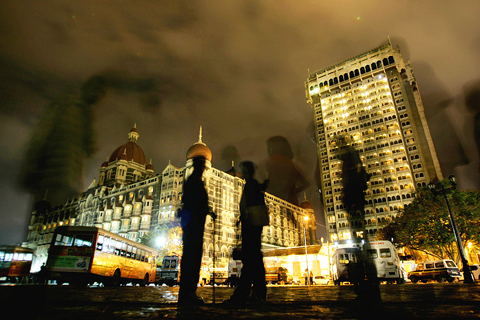The deadly Islamist militant strike on India’s financial nerve center clouded the future of Asia’s third-largest economy at a time when it already faces a significant slowdown, analysts said.
Gunmen stormed luxury hotels, including the iconic Taj Mahal Palace, a landmark restaurant and the main train station, killing at least 195 people in a brazen attack that paralysed Mumbai for 60 hours.
The murderous rampage, which Indians are calling their own Sept. 11, was clearly intended to “destabilize markets and scare off tourists,” said Nikhilesh Bhattacharyya, an economist at Moody’s Economy.com.

PHOTO: AP
The attack — which also saw the gunmen single out Americans, Britons and Israelis — “signifies an attack by extremists on India’s economic success and its closer and warmer economic and diplomatic ties with the West,” said Deepak Lalwani, India director at London’s Astaire and Partners.
And the timing of the attack, the most devastating of a string this year, was “abysmal” from an Indian economic viewpoint, he said.
The stock market was down 55 percent this year, banks are facing a huge fund outflow due to the global financial crisis, the rupee is at record lows and growth has slowed significantly amid a widening global recession.
“There has been a continuing attempt to undermine India’s economy over the past four or five years and this [attack] is part of it,” said Ajai Sahni, head of the New Delhi-based Institute for Conflict Management.
The images of gunbattles between militants and commandoes “flashed around the world are not going to be helpful,” said a Singapore banker on condition of anonymity.
“The effect on investor sentiment and tourism will be pronounced,” he said.
Indian Finance Minister Palaniappan Chidambaram conceded the attacks could have a “negative” short-term impact but insisted the economy would “overcome” it.
“Investor sentiment will be affected. But within a few weeks or months it will recover,” he said. India remains “an attractive investment destination.”
He expected growth of at least 7 percent for this year to March after three years of at least 9 percent expansion. However, economists forecast growth as low as 6 percent this year and 4 percent for next year.
In the immediate aftermath, the attacks will scare away tourists and business travelers, analysts say.
“The singling out of American, British and Israelis as hostages indicates a new and worrying action by terrorists as this indicates an international agenda being fought on Indian soil,” Lalwani said.
“The impact on tourism will be horrible. People will be scared, worried,” said Vijay Prakash, manager of a posh Mumbai restaurant.
Foreign investors would “likely be worried about the safety of their employees and establishments,” said Rajeev Malik, economist at Australia’s Macquarie Research.
But in the longer term, as long as there are no major follow-up attacks, the impact should recede, analysts said.
The “negative effects of the current attacks on tourism, investor confidence, rupee and equities will probably turn out to be temporary,” Malik said.
Also “what the Islamist terrorist movement has been able to demonstrate in the past few years there is no place you can that is completely safe,” said security expert Robert Ayers at London’s Chatham House, an international affairs think tank.
“If people made inward investments based on the fear of terrorist attacks, there would be no investments … in all sorts of the places,” he said.
However, Sahni said: “If we keep seeing attacks of this magnitude, perceptions of India’s security are going to shift and it will impact directly on investment decisions.”

With this year’s Semicon Taiwan trade show set to kick off on Wednesday, market attention has turned to the mass production of advanced packaging technologies and capacity expansion in Taiwan and the US. With traditional scaling reaching physical limits, heterogeneous integration and packaging technologies have emerged as key solutions. Surging demand for artificial intelligence (AI), high-performance computing (HPC) and high-bandwidth memory (HBM) chips has put technologies such as chip-on-wafer-on-substrate (CoWoS), integrated fan-out (InFO), system on integrated chips (SoIC), 3D IC and fan-out panel-level packaging (FOPLP) at the center of semiconductor innovation, making them a major focus at this year’s trade show, according

DEBUT: The trade show is to feature 17 national pavilions, a new high for the event, including from Canada, Costa Rica, Lithuania, Sweden and Vietnam for the first time The Semicon Taiwan trade show, which opens on Wednesday, is expected to see a new high in the number of exhibitors and visitors from around the world, said its organizer, SEMI, which has described the annual event as the “Olympics of the semiconductor industry.” SEMI, which represents companies in the electronics manufacturing and design supply chain, and touts the annual exhibition as the most influential semiconductor trade show in the world, said more than 1,200 enterprises from 56 countries are to showcase their innovations across more than 4,100 booths, and that the event could attract 100,000 visitors. This year’s event features 17

EXPORT GROWTH: The AI boom has shortened chip cycles to just one year, putting pressure on chipmakers to accelerate development and expand packaging capacity Developing a localized supply chain for advanced packaging equipment is critical for keeping pace with customers’ increasingly shrinking time-to-market cycles for new artificial intelligence (AI) chips, Taiwan Semiconductor Manufacturing Co (TSMC, 台積電) said yesterday. Spurred on by the AI revolution, customers are accelerating product upgrades to nearly every year, compared with the two to three-year development cadence in the past, TSMC vice president of advanced packaging technology and service Jun He (何軍) said at a 3D IC Global Summit organized by SEMI in Taipei. These shortened cycles put heavy pressure on chipmakers, as the entire process — from chip design to mass

Germany is to establish its first-ever national pavilion at Semicon Taiwan, which starts tomorrow in Taipei, as the country looks to raise its profile and deepen semiconductor ties with Taiwan as global chip demand accelerates. Martin Mayer, a semiconductor investment expert at Germany Trade & Invest (GTAI), Germany’s international economic promotion agency, said before leaving for Taiwan that the nation is a crucial partner in developing Germany’s semiconductor ecosystem. Germany’s debut at the international semiconductor exhibition in Taipei aims to “show presence” and signal its commitment to semiconductors, while building trust with Taiwanese companies, government and industry associations, he said. “The best outcome